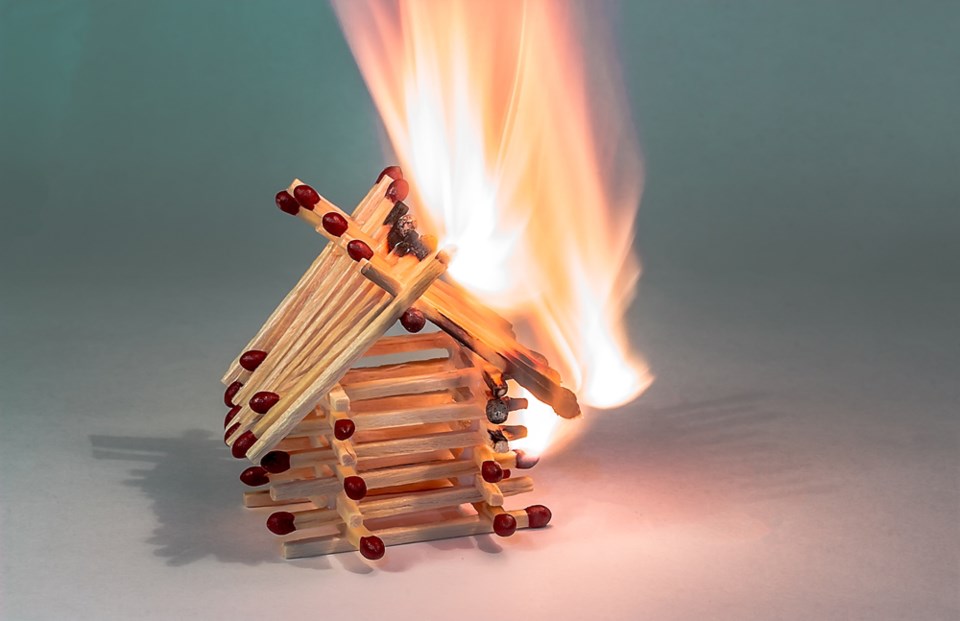A month after a wildfire was sparked in the Upper Squamish Valley, authorities are still not able to call it out.
The wildfire, which started burning at the 17.5-mile mark of Squamish Valley Road on April 1, was reportedly started when a homeowner’s slash fire got out of control.
At one point, the fire came within 100 metres of a home.
At its height, the blaze’s perimeter was mapped at 68 hectares.
“It is still called under control. We are still patrolling it periodically,” said Donna MacPherson, fire information officer for the Coastal Fire Centre. “We aren’t willing to call it out until we get through this little spate of windy and dry weather.”
During the hot part of the day, BC WildFire Service personnel go into the fire area and see if it has been reactivated, MacPherson said.
“Fire [can] look out in the morning, and then it gets a little bit of heat and wind on it and it starts to put up a little bit of smoke,” she said. “If you don’t get on it, it will rekindle just like a campfire does when you blow on it.”
During the mop-up stage of fighting wildfires, crews walk through and look for smoke that is coming up from underground or for warmth in the logs themselves.
“They touch them to see if they are warm in the middle...if they are warmer than they should be, then they know there is probably fire at the core.”
If that is the case, firefighters take that tree, cut it down, break it down, wet it and bury it, MacPherson explained.
BC Wildfire firefighters also have infrared scanners they can use to try and find heat underground.
Preventing wildfires
Open air burning is prohibited within the District of Squamish.
[Industry related forestry/slash pile burns are permitted in Squamish with a provincial burn registration number.]
“What we think is that people don’t realize — they are looking at the calendar and it is April, but you still have to look at how hot and dry and windy it is as well,” MacPherson said.
In Oyster River on Vancouver Island on Aug. 28, three separate fires were sparked by open burning.
“We are getting unusually low... ‘relative humidity’ — that is a measure of how dry the air is — and then increasing winds and then sun and that combines together to dry out that stuff that is on the surface of the ground.”
Squamish homeowners are currently allowed campfires with a District campfire permit. Campfires must be no more than half a metre high and half a metre in diameter. Only dry firewood can be burned.
All fires should be monitored closely.
“We mean actually standing beside it, not having a cup of tea inside,” she said. “And when you leave it, it has to be out cold.”
MacPherson said people sometimes mistakenly think their campfire is out when it isn’t.
“They think it is out — it is black and just smoking a little bit, but they don’t see that as actual fire, and yet it is burning. It is just burning at a lower intensity,” she said, adding if the day gets hotter and drier or the wind picks up, that can rekindle.
“And off it goes,” she said.
Wildfire is also burning in Mount Currie. It was approximately 90 hectares as of Monday.
“It is a re-light of a fire that happened earlier in the season,” MacPherson said.
Human activity reportedly caused that original fire.
It is within the Mount Currie Volunteer Fire Department of the Lil’wat First Nation.
Several calls to the Nation for more information were not returned by press deadline.
According to the BC Wildfire Service, the Mount Currie fire is “being held,” which means it is unlikely to spread given the current conditions.
Abbott-chapman Action Plan Update April 30 2019 by Jennifer Thuncher on Scribd
Government action plan
On Tuesday, the provincial government released its action plan, “Responding to Wildfire and Flood Risks.”
The plan highlights a 58 per cent increase in wildfire management funding — $101 million up from $64 million.
This includes 80 more BC Wildfire Service firefighters.
The report also notes a focus on modernizing emergency support services so that services are implemented sooner.
The report is an update to a 2018 action plan based on the Chief Maureen Chapman and George Abbott recommendations after the devastating 2017 wildfire season. The next update will be in October.
The province aims to have a Climate Change Adaption Strategy complete in 2020.
Be Fire Smart, Squamish
The next community-chipping day is this Sunday. Residents can dispose of combustibles from their yards.
The following addresses are part of this chipping day:
*1534 to 1589 Arrowhead Rd.
*1345, 1355 (Lots 1-5), 1375, 1385, 1391, 1395, 1499 & 1511 Depot Rd.
*41824, 41844, 41852, 41864, 41882, 41886, 41890, 41892, 41894, 41950, 42025, 42027, 42035, 42047, 42063, 42069, 42097 Government Rd.
*41818 to 42081 Ross Rd.
*41744 to 41841 Woodland Pl.
Go to Squamish.ca and search “Fire Smart” for more information.



